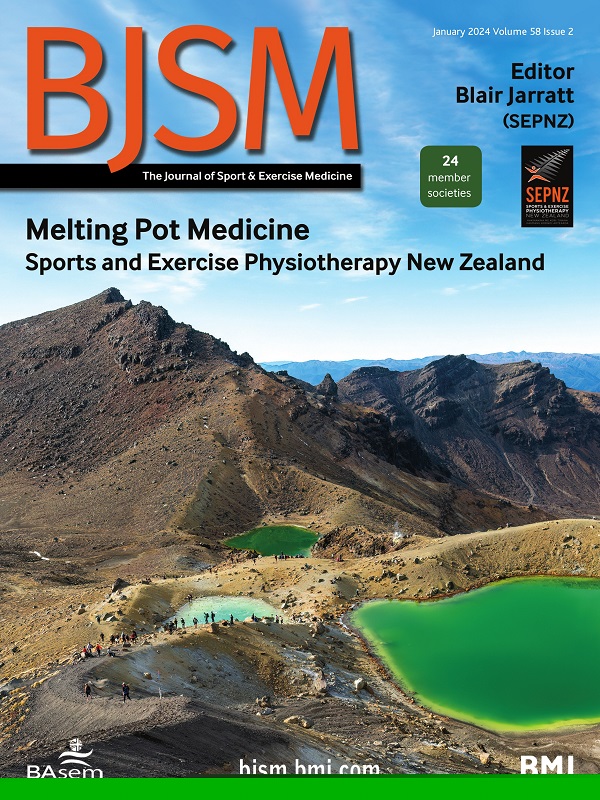Interpreting p values and interval estimates based on practical relevance: guidance for the sports medicine clinician
IF 16.2
1区 医学
Q1 SPORT SCIENCES
引用次数: 0
Abstract
Statistical methods are employed in medical research to estimate effects of treatments or health conditions across populations.1 2 This paper presents a framework to avoid common misinterpretations that undermine clinical decision-making.1 3 A convention in scientific articles is to report three statistical results: a point estimate, a p value and an interval estimate usually called ‘CI’.2 3 A point estimate is a value computed from the data that represents the ‘best guess’ about the studied effect; for example, the mean recovery time in a treatment group is the ‘best guess’ about the mean recovery time in the whole population receiving the treatment. The p value ‘p’ is a number between 0 and 1 used to assess the compatibility —also known as the consistency, consonance or agreement—between the data and a hypothesis about the effect (eg, the null hypothesis of zero treatment effect). The interval estimate is the range of the guesses about the effect with which the observed data are reasonably compatible, according to the method used to compute the interval.3–9 This editorial aims to guide the interpretation of p values and interval estimates for the sports medicine clinician. We present a series of recommendations for interpreting statistics through the compatibility viewpoint. Compatibility refers to how well the hypothesis fits or explains the data; compatibility is highest when p=1 and decreases as p approaches 0.3–6 10 Interpreting p values as measures of compatibility is an alternative to the traditional ‘significance’ interpretation; indeed, the latter is often misunderstood as referring to clinical significance and requires strong assumptions to justify its use for decisions.1 3–6 The minimum for reasonable compatibility is typically set at p=0.05, yielding a 100×(1–0.05)%=95% compatibility interval that is numerically identical to a ‘95% CI’ and so is also denoted as ‘95% CI’. Box …基于实际相关性的p值和区间估计的解释:对运动医学临床医生的指导
医学研究中采用统计方法来估计治疗或健康状况对人群的影响。本文提出了一个框架,以避免破坏临床决策的常见误解。科学论文的惯例是报告三个统计结果:点估计、p值和通常称为CI的区间估计。点估计值是从数据中计算出来的值,它代表了对研究效应的“最佳猜测”;例如,治疗组的平均恢复时间是对接受治疗的整个人群平均恢复时间的“最佳猜测”。p值‘ p ’是一个介于0和1之间的数字,用于评估数据与关于效果的假设(例如,零治疗效果的零假设)之间的兼容性-也称为一致性,一致性或一致性。区间估计值是根据计算区间的方法,对观测数据合理兼容的效果的猜测范围。3-9这篇社论旨在指导运动医学临床医生解释p值和区间估计。我们提出了一系列从兼容性角度解释统计数据的建议。相容性是指假设与数据吻合或解释数据的程度;当p=1时相容性最高,当p接近0.3 - 10时相容性降低,将p值解释为相容性的度量是传统“重要性”解释的替代方法;事实上,后者经常被误解为指临床意义,需要强有力的假设来证明其用于决策的合理性。合理兼容性的最小值通常设置为p=0.05,产生100×(1 - 0.05)%=95%的兼容性区间,在数字上与“95% CI”相同,因此也表示为“95% CI”。箱……
本文章由计算机程序翻译,如有差异,请以英文原文为准。
求助全文
约1分钟内获得全文
求助全文
来源期刊
CiteScore
27.10
自引率
4.90%
发文量
217
审稿时长
3-8 weeks
期刊介绍:
The British Journal of Sports Medicine (BJSM) is a dynamic platform that presents groundbreaking research, thought-provoking reviews, and meaningful discussions on sport and exercise medicine. Our focus encompasses various clinically-relevant aspects such as physiotherapy, physical therapy, and rehabilitation. With an aim to foster innovation, education, and knowledge translation, we strive to bridge the gap between research and practical implementation in the field. Our multi-media approach, including web, print, video, and audio resources, along with our active presence on social media, connects a global community of healthcare professionals dedicated to treating active individuals.

 求助内容:
求助内容: 应助结果提醒方式:
应助结果提醒方式:


